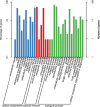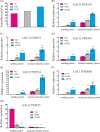Combined use of specific length amplified fragment sequencing (SLAF-seq) and bulked segregant analysis (BSA) for rapid identification of genes influencing fiber content of hemp (Cannabis sativa L.)
- PMID: 35596150
- PMCID: PMC9123736
- DOI: 10.1186/s12870-022-03594-w
Combined use of specific length amplified fragment sequencing (SLAF-seq) and bulked segregant analysis (BSA) for rapid identification of genes influencing fiber content of hemp (Cannabis sativa L.)
Abstract
Hemp (Cannabis sativa L.), an ancient crop, is a significant source of high-quality fiber that primarily caters to the textile industry worldwide. Fiber content is a crucial quantitative trait for evaluating fiber yield in hemp. Understanding the genetic mechanisms involved in hemp breeding is essential for improving yield. In this study, we developed 660 F1 plants from a cross between Jindao-15 (high fiber content fiber-use variety) and Fire No.1 (low fiber content fiber-use variety), and thirty plants each with high and low fiber content were selected from 305 monoecious plants of this population according to 5%-10% of population size for quantitative traits. The DNA from these plants was extracted to establish two bulk DNA pools and then subjected to the restriction digestion by the enzymes RsaI and HaeIII to obtain 314-364 bp digestion fragments and subjected to sequencing using specific length amplified fragment sequencing (SLAF-seq). Finally, we successfully developed 368,404 SLAF tags, which led to the detection of 25,133 high-quality SNPs. Combing with the resequencing results of parents, the SNPs of mixed pools were then subjected to the SNP-Index correlation algorithm, which revealed four candidate regions related to fiber content traits on Chromosome 1, with a length of 8.68 Mb and containing 389 annotated genes. The annotation information and the comparison results identified 15 genes that were highly likely to modulate the fiber content of hemp. Further, qPCR validation identified six genes (LOC115705530, LOC115705875, LOC115704794, LOC115705371, LOC115705688 and LOC115707511) that were highly positively correlated with influencing the hemp fiber content. These genes were involved in the transcription regulation, auxin and water transportion, one carbon and sugar metabolism. And non-synnoumous mutation SNPs which may play vital role in influencing the fiber content were detected in LOC115705875, LOC115704794, LOC115705688 and LOC115707511. Thus, our study highlights the importance of the combined use of SLAF-Seq and Bulked Segregant analysis (BSA) to locate genes related to hemp fiber content rapidly. Hence, our study provides novel mechanistic inputs for the fast identification of genes related to important agronomic traits of hemp and other crops catering to the textile industry.
Keywords: Bulked Segregant analysis; Candidate gene; Hemp fiber content; SNP analysis; Specific length amplified fragment sequencing.
© 2022. The Author(s).
Conflict of interest statement
The authors declare that they have no competing interests.
Figures








Similar articles
-
Mining candidate genes associated with powdery mildew resistance in cucumber via super-BSA by specific length amplified fragment (SLAF) sequencing.BMC Genomics. 2015 Dec 14;16:1058. doi: 10.1186/s12864-015-2041-z. BMC Genomics. 2015. PMID: 26668009 Free PMC article.
-
Physical mapping and candidate gene prediction of fertility restorer gene of cytoplasmic male sterility in cotton.BMC Genomics. 2018 Jan 2;19(1):6. doi: 10.1186/s12864-017-4406-y. BMC Genomics. 2018. PMID: 29295711 Free PMC article.
-
Rapid Identification of Candidate Genes for Seed Weight Using the SLAF-Seq Method in Brassica napus.PLoS One. 2016 Jan 29;11(1):e0147580. doi: 10.1371/journal.pone.0147580. eCollection 2016. PLoS One. 2016. PMID: 26824525 Free PMC article.
-
The Complex Interactions Between Flowering Behavior and Fiber Quality in Hemp.Front Plant Sci. 2019 May 16;10:614. doi: 10.3389/fpls.2019.00614. eCollection 2019. Front Plant Sci. 2019. PMID: 31156677 Free PMC article. Review.
-
From fibers to flowering to metabolites: unlocking hemp (Cannabis sativa) potential with the guidance of novel discoveries and tools.J Exp Bot. 2025 Jan 1;76(1):109-123. doi: 10.1093/jxb/erae405. J Exp Bot. 2025. PMID: 39324630 Free PMC article. Review.
Cited by
-
Identification of Leaf Stripe Resistance Genes in Hulless Barley Landrace Teliteqingke from Qinghai-Tibet Plateau.Int J Mol Sci. 2025 Jan 28;26(3):1133. doi: 10.3390/ijms26031133. Int J Mol Sci. 2025. PMID: 39940899 Free PMC article.
-
Influence of harvest timing on sugarcane quality parameters in ecuador: a multivariate analysis using PCA and MANOVA biplot.Sci Rep. 2025 May 22;15(1):17737. doi: 10.1038/s41598-025-93393-8. Sci Rep. 2025. PMID: 40404857 Free PMC article.
References
-
- Avico U, Pacifici R, Zuccaro P. Variations of tetrahydrocannabinol content in cannabis plants to distinguish the fibre-type from drug-type plants. Bull Narc. 1985;37(4):61–65. - PubMed
-
- Natalia M, Tatyana C, Dmitry G, Oleg G, Tatyana G: Key Stages of Fiber Development as Determinants of Bast Fiber Yield and Quality. Fibers 2018, 6(2).
-
- Sanjay MR, Arpitha GR, Yogesha B. Study on Mechanical Properties of Natural - Glass Fibre Reinforced Polymer Hybrid Composites: A Review. Materials Today: Proceedings. 2015;2(4):2959–2967.
MeSH terms
LinkOut - more resources
Full Text Sources
Other Literature Sources
Miscellaneous

